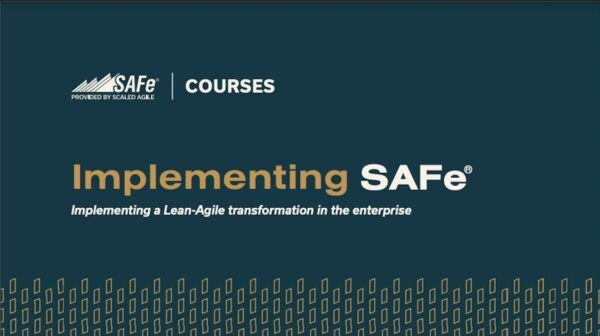By taking the Implementing SAFe course, you will gain a deep understanding of every layer of a SAFe implementation. This Training is designed for individuals seeking to lead a Lean-Agile transformation and offers the necessary guidance and tools to effectively lead teams in remote settings. Through this course, you will learn about the roles of each person involved in SAFe and develop the skills to plan and direct a successful SAFe transformation. You will also gain expertise in identifying value streams, launching agile release trains, building a Lean-Agile portfolio, and applying principles of Agile product management and delivery. This course is ideal for those who want to gain a comprehensive and practical understanding of how to effectively support an organization in achieving business agility.
Course Outline
Day 1
- Thriving in the Digital Age with Business Agility
- Becoming a Lean-Agile Leader
- Establishing Team and Technical Agility
Day 2
- Building Solutions with Agile Product Delivery
- Exploring Lean Portfolio Management
- Leading the Change
- Practicing SAFe
Day 3
- Reaching the SAFe Tipping Point
- Designing the Implementation
- Launching an Agile Release Train
- Coaching ART Execution
Day 4
- Extending to the Portfolio
- Accelerating Business Agility
- Becoming a SAFe Practice Consultant
- Open Space

Implementing SAFe attendees learn:
- How to coach a SAFe transformation
- How to launch Agile Release Trains
- How to identify Value Streams
- How to build solutions with Agile Product Delivery
- How to empower a Lean portfolio
- How to understand each role within a SAFe implementation

Implementing SAFe attendees typically include
- Professional Services Consultants
- Internal Change Agents, Lean-Agile Center for Excellence, Agile Working Groups
- Business and Technology Executives and Leaders, Managers, Directors
- Portfolio Managers and Fiduciaries, Project/Program Management Office (PMO) personnel
- Development, QA and IT management
- Program and Project Managers
- Product and Product Line Managers
- Process Leads and Lifecycle Governance Personnel
- Enterprise, System and Solution Architects
What’s included
- Course materials
- Remote learning via SAFe® Virtual Classrooms
- One-year membership to the SAFe® Community Platform
- SAFe Practice Consultant (SPC) Certification Exam1

Upcoming Implementing SAFe Training
Implementing SAFe Training: A Win-Win for Participants and Employers
Implementing SAFe (Scaled Agile Framework) training is a valuable investment for both participants and their employers. SAFe is a leading framework for scaling Agile practices to large enterprises, and organizations that implement SAFe can achieve significant benefits, such as improved product quality, faster time to market, and increased customer satisfaction.
Participants in Implementing SAFe training gain a deep understanding of the SAFe principles and practices, and they learn how to apply SAFe to their own organization. They also learn how to lead and coach others in SAFe, and they develop the skills they need to be successful in SAFe roles.
The Implementing SAFe (SAFe) training course is designed to teach participants how to implement SAFe in their organization. The course covers a wide range of topics, including:
- The principles and practices of SAFe
- The different roles and responsibilities in a SAFe organization
- How to plan and execute a SAFe transformation
- How to measure and improve the performance of a SAFe organization
The JLS Implementing SAFe course are delivered by an experienced SAFe Fellow and SPCT who can share insights and best practices with participants. Participants will also have the opportunity to network with other professionals and learn from their experiences.
Benefits for Employers
Organizations that invest in Implementing SAFe training for their employees can expect to benefit in a number of ways, including:
- Improved product quality: SAFe helps organizations to deliver high-quality products and services to their customers.
- Faster time to market: SAFe helps organizations to reduce the time it takes to bring new products and services to market.
- Increased customer satisfaction: SAFe helps organizations to deliver products and services that meet the needs and expectations of their customers.
- Reduced costs: SAFe helps organizations to reduce costs by improving efficiency and reducing waste.
- Improved employee engagement: SAFe is a collaborative framework that empowers employees to take ownership of their work. This can lead to improved employee engagement and job satisfaction.
Benefits for Participants
Participants in Implementing SAFe training can expect to benefit in a number of ways, including:
- Increased knowledge and skills: Participants gain a deep understanding of the SAFe principles and practices, and they learn how to apply SAFe to their own organization.
- Improved career opportunities: SAFe is a highly sought-after skill, and Implementing SAFe training can make participants more competitive in the job market.
- Personal growth and development: Implementing SAFe training is a challenging but rewarding experience. Participants learn how to lead and coach others, and they develop valuable transferable skills.
Conclusion
Implementing SAFe training is a valuable investment for both participants and their employers. Participants gain the knowledge and skills they need to be successful in SAFe roles, and organizations benefit from improved product quality, faster time to market, increased customer satisfaction, and reduced costs.
If you are considering Implementing SAFe training, be sure to choose a reputable training provider that offers a comprehensive course. You should also make sure that the delivery of the training is tailored to your specific needs and goals.


